Abstract
The airway response to increasing concentrations of inhaled-adenosine and histamine after oral theophylline or matched placebo was studied in nine asthmatic subjects. Changes in airway calibre were followed as sGaw and FEV1 and concentration-response curves constructed. Inhaled adenosine caused concentration-related bronchoconstriction and was four-five times less potent than inhaled histamine. Theophylline, which achieved a mean plasma level of 15.9 and 16.6 micrograms/ml on the histamine and adenosine study days respectively, caused significant increases in FEV1 (17%) and sGaw (41-53%) whereas placebo had no effect. Theophylline also protected the airways against histamine-and adenosine-induced bronchoconstriction. However theophylline had a greater protective effect against adenosine (concentration-ratio 17.4 for FEV1 and 12.8 for sGaw) than against histamine (concentration ratio 5.6 for FEV1 and 5.4 for sGaw (P less than 0.05]. At therapeutic concentrations theophylline is a specific antagonist of the airway effects of adenosine in addition to being a bronchodilator and a functional antagonist.
Full text
PDF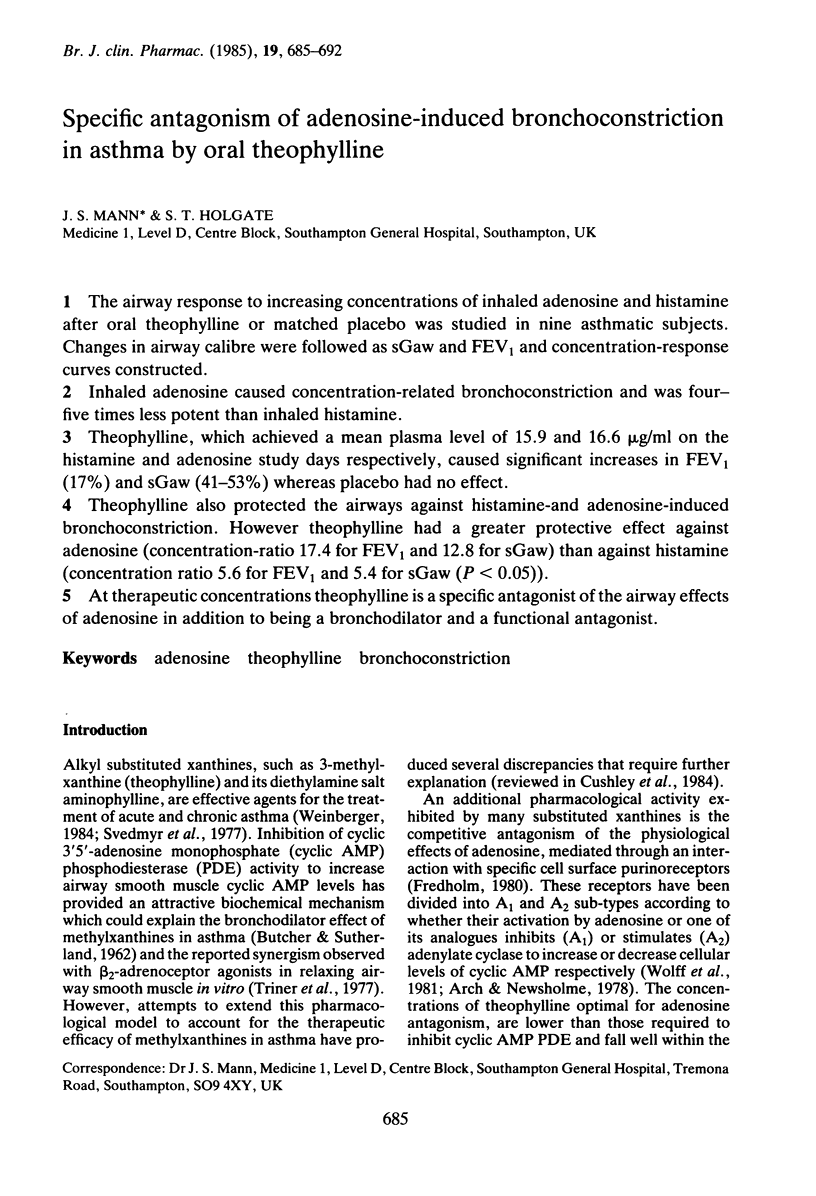

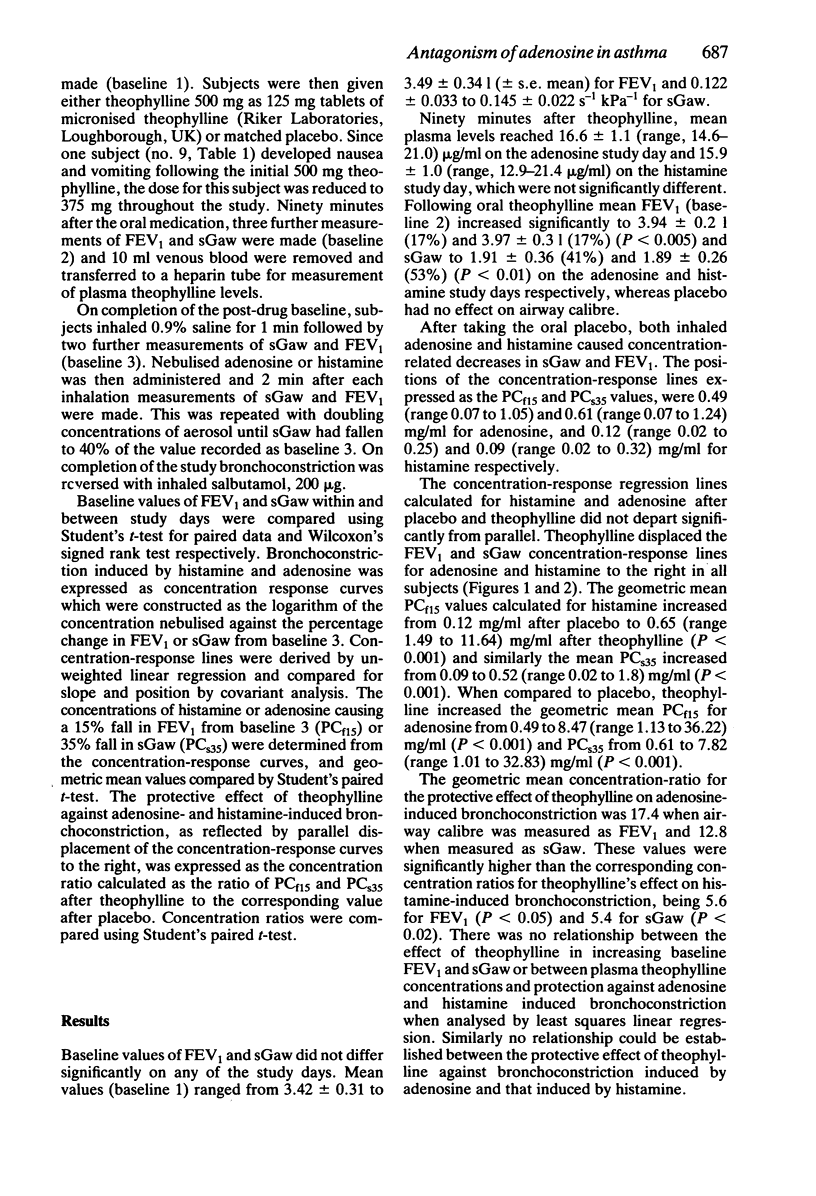
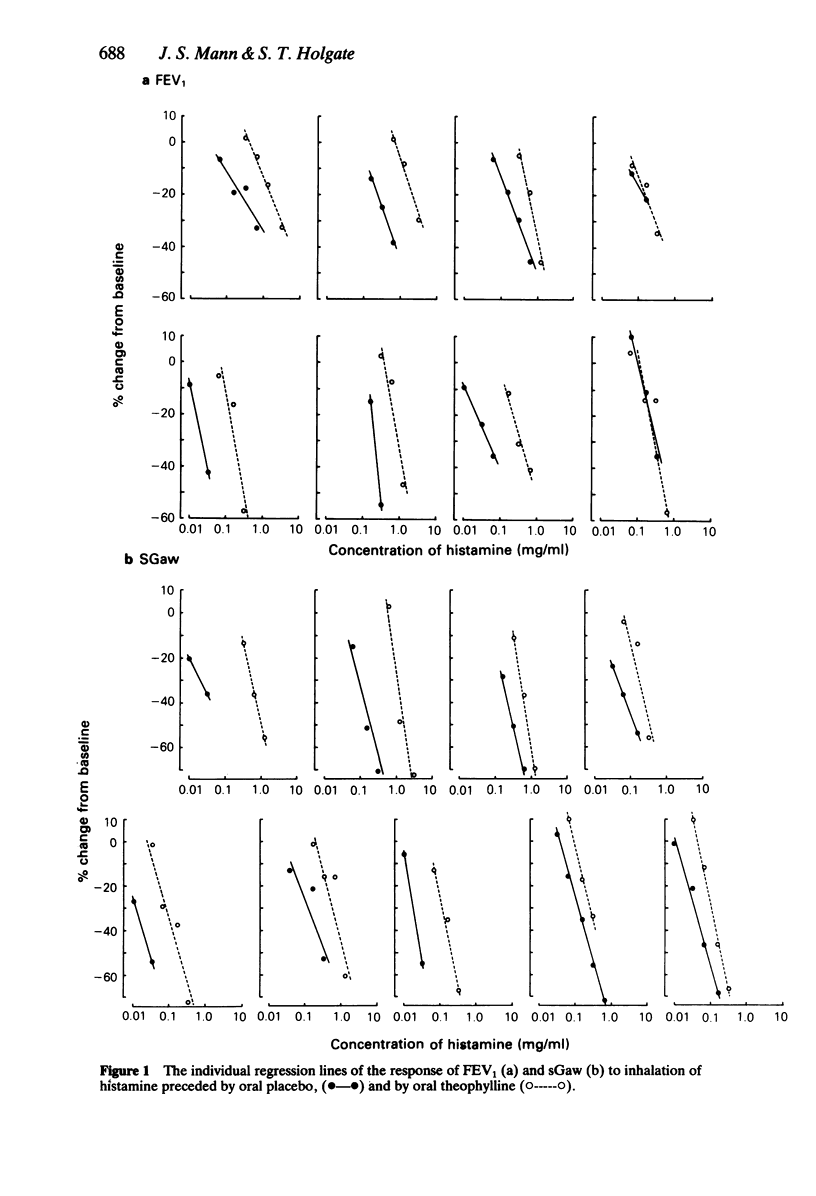
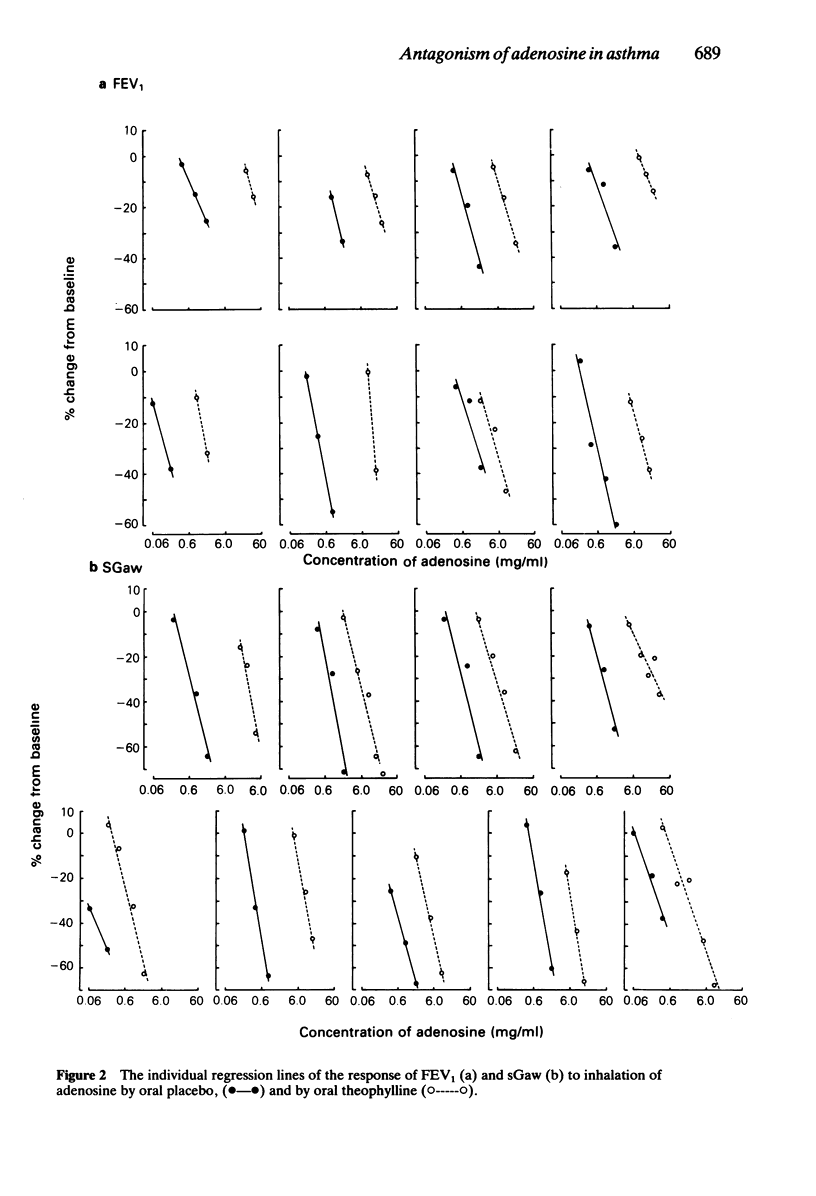
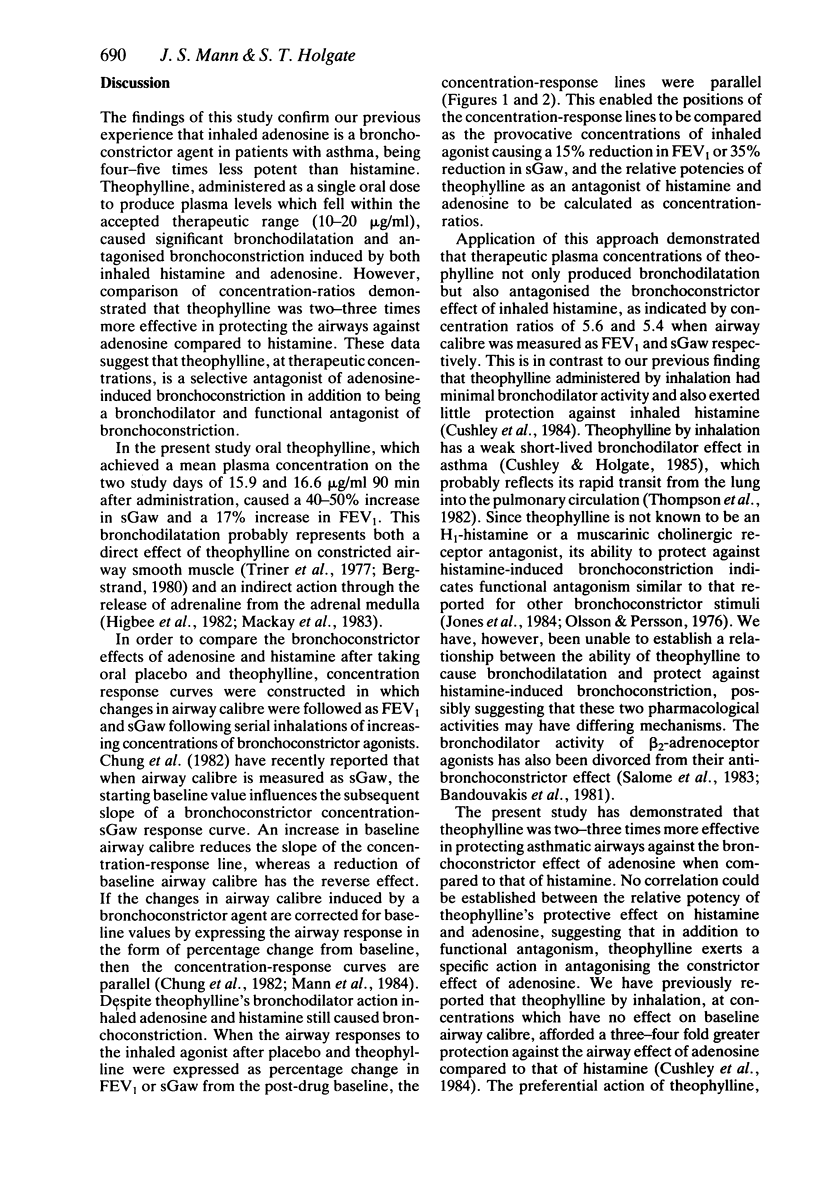
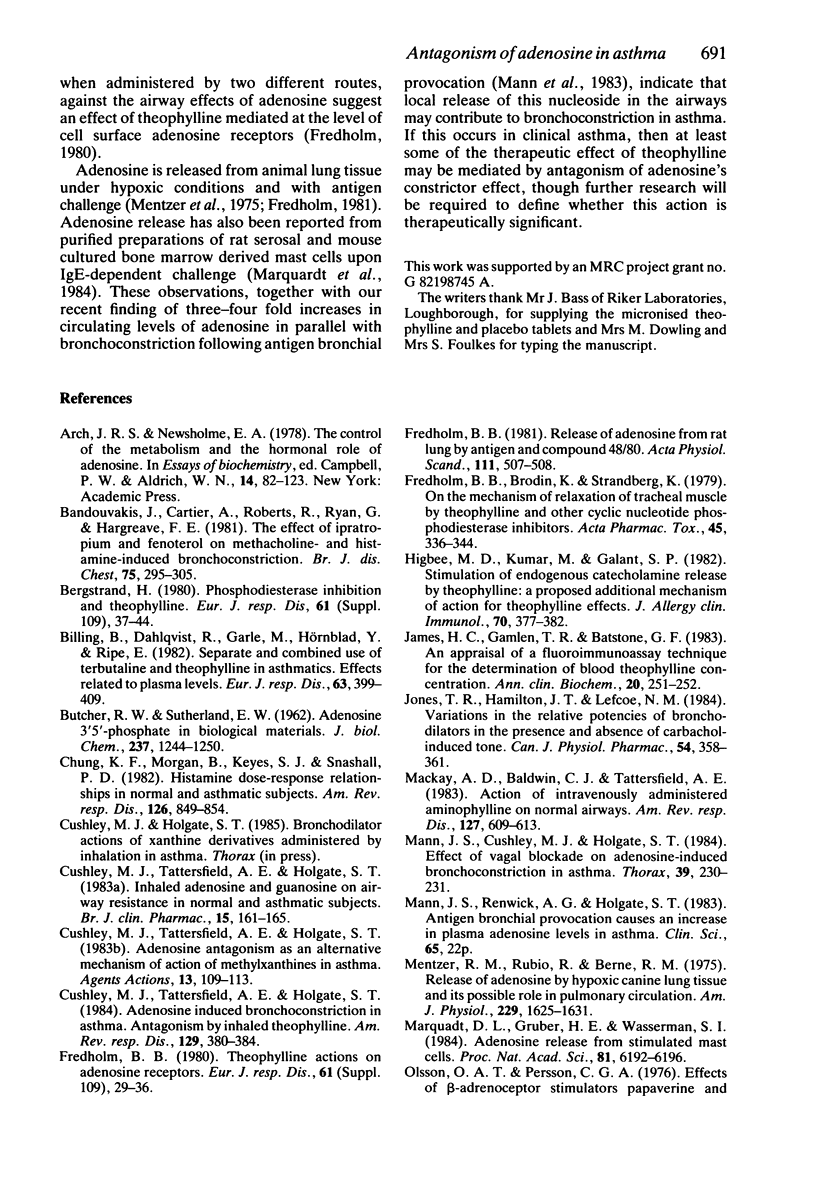
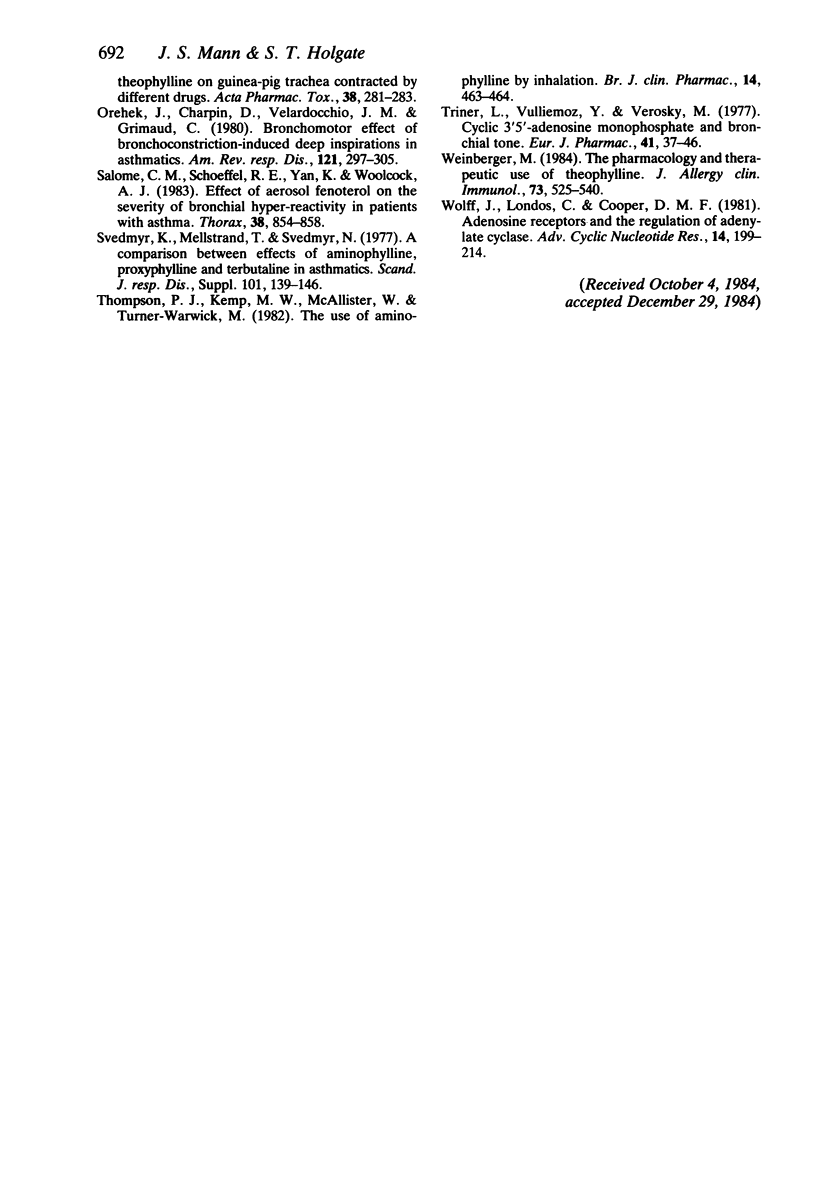
Selected References
These references are in PubMed. This may not be the complete list of references from this article.
- Arch J. R., Newsholme E. A. The control of the metabolism and the hormonal role of adenosine. Essays Biochem. 1978;14:82–123. [PubMed] [Google Scholar]
- BUTCHER R. W., SUTHERLAND E. W. Adenosine 3',5'-phosphate in biological materials. I. Purification and properties of cyclic 3',5'-nucleotide phosphodiesterase and use of this enzyme to characterize adenosine 3',5'-phosphate in human urine. J Biol Chem. 1962 Apr;237:1244–1250. [PubMed] [Google Scholar]
- Bandouvakis J., Cartier A., Roberts R., Ryan G., Hargreave F. E. The effect of ipratropium and fenoterol on methacholine-histamine-induced bronchoconstriction. Br J Dis Chest. 1981 Jul;75(3):295–305. doi: 10.1016/0007-0971(81)90009-7. [DOI] [PubMed] [Google Scholar]
- Bergstrand H. Phosphodiesterase inhibition and theophylline. Eur J Respir Dis Suppl. 1980;109:37–44. [PubMed] [Google Scholar]
- Billing B., Dahlqvist R., Garle M., Hörnblad Y., Ripe E. Separate and combined use of terbutaline and theophylline in asthmatics. Effects related to plasma levels. Eur J Respir Dis. 1982 Sep;63(5):399–409. [PubMed] [Google Scholar]
- Chung K. F., Morgan B., Keyes S. J., Snashall P. D. Histamine dose-response relationships in normal and asthmatic subjects. The importance of starting airway caliber. Am Rev Respir Dis. 1982 Nov;126(5):849–854. doi: 10.1164/arrd.1982.126.5.849. [DOI] [PubMed] [Google Scholar]
- Cushley M. J., Tattersfield A. E., Holgate S. T. Adenosine antagonism as an alternative mechanism of action of methylxanthines in asthma. Agents Actions Suppl. 1983;13:109–113. [PubMed] [Google Scholar]
- Cushley M. J., Tattersfield A. E., Holgate S. T. Adenosine-induced bronchoconstriction in asthma. Antagonism by inhaled theophylline. Am Rev Respir Dis. 1984 Mar;129(3):380–384. doi: 10.1164/arrd.1984.129.3.380. [DOI] [PubMed] [Google Scholar]
- Cushley M. J., Tattersfield A. E., Holgate S. T. Inhaled adenosine and guanosine on airway resistance in normal and asthmatic subjects. Br J Clin Pharmacol. 1983 Feb;15(2):161–165. doi: 10.1111/j.1365-2125.1983.tb01481.x. [DOI] [PMC free article] [PubMed] [Google Scholar]
- Fredholm B. B., Brodin K., Strandberg K. On the mechanism of relaxation of tracheal muscle by theophylline and other cyclic nucleotide phosphodiesterase inhibitors. Acta Pharmacol Toxicol (Copenh) 1979 Nov;45(5):336–344. doi: 10.1111/j.1600-0773.1979.tb02402.x. [DOI] [PubMed] [Google Scholar]
- Fredholm B. B. Release of adenosine from rat lung by antigen and compound 48/80. Acta Physiol Scand. 1981 Apr;111(4):507–508. doi: 10.1111/j.1748-1716.1981.tb06772.x. [DOI] [PubMed] [Google Scholar]
- Fredholm B. B. Theophylline actions on adenosine receptors. Eur J Respir Dis Suppl. 1980;109:29–36. [PubMed] [Google Scholar]
- Higbee M. D., Kumar M., Galant S. P. Stimulation of endogenous catecholamine release by theophylline: a proposed additional mechanism of action for theophylline effects. J Allergy Clin Immunol. 1982 Nov;70(5):377–382. doi: 10.1016/0091-6749(82)90028-8. [DOI] [PubMed] [Google Scholar]
- James H. C., Gamlen T. R., Batstone G. F. An appraisal of a fluoro-immuno assay technique for the determination of blood theophylline concentration. Ann Clin Biochem. 1983 Jul;20(Pt 4):251–252. doi: 10.1177/000456328302000413. [DOI] [PubMed] [Google Scholar]
- Mackay A. D., Baldwin C. J., Tattersfield A. E. Action of intravenously administered aminophylline on normal airways. Am Rev Respir Dis. 1983 May;127(5):609–613. doi: 10.1164/arrd.1983.127.5.609. [DOI] [PubMed] [Google Scholar]
- Marquardt D. L., Gruber H. E., Wasserman S. I. Adenosine release from stimulated mast cells. Proc Natl Acad Sci U S A. 1984 Oct;81(19):6192–6196. doi: 10.1073/pnas.81.19.6192. [DOI] [PMC free article] [PubMed] [Google Scholar]
- Mentzer R. M., Jr, Rubio R., Berne R. M. Release of adenosine by hypoxic canine lung tissue and its possible role in pulmonary circulation. Am J Physiol. 1975 Dec;229(6):1625–1631. doi: 10.1152/ajplegacy.1975.229.6.1625. [DOI] [PubMed] [Google Scholar]
- Olsson O. A., Persson C. G. Effect of beta-adrenoceptor stimulators, papaverine and theophylline on guinea-pig trachea contracted by different drugs. Acta Pharmacol Toxicol (Copenh) 1976 Mar;38(3):281–283. doi: 10.1111/j.1600-0773.1976.tb03121.x. [DOI] [PubMed] [Google Scholar]
- Orehek J., Charpin D., Velardocchio J. M., Grimaud C. Bronchomotor effect of bronchoconstriction-induced deep inspirations in asthmatics. Am Rev Respir Dis. 1980 Feb;121(2):297–305. doi: 10.1164/arrd.1980.121.2.297. [DOI] [PubMed] [Google Scholar]
- Salome C. M., Schoeffel R. E., Yan K., Woolcock A. J. Effect of aerosol fenoterol on the severity of bronchial hyperreactivity in patients with asthma. Thorax. 1983 Nov;38(11):854–858. doi: 10.1136/thx.38.11.854. [DOI] [PMC free article] [PubMed] [Google Scholar]
- Svedmyr K., Mellstrand T., Svedmyr N. A comparison between effects of aminophylline, proxyphylline and terbutaline in asthmatics. Scand J Respir Dis Suppl. 1977;101:139–146. [PubMed] [Google Scholar]
- Thompson P. J., Kemp M. W., McAllister W., Turner-Warwick M. The use of aminophylline by inhalation. Br J Clin Pharmacol. 1982 Sep;14(3):463–464. doi: 10.1111/j.1365-2125.1982.tb02011.x. [DOI] [PMC free article] [PubMed] [Google Scholar]
- Triner L., Vulliemoz Y., Verosky M. Cyclic 3',5'-adenosine monophosphate and bronchial tone. Eur J Pharmacol. 1977 Jan 7;41(1):37–46. doi: 10.1016/0014-2999(77)90368-5. [DOI] [PubMed] [Google Scholar]
- Weinberger M. The pharmacology and therapeutic use of theophylline. J Allergy Clin Immunol. 1984 May;73(5 Pt 1):525–540. doi: 10.1016/0091-6749(84)90505-0. [DOI] [PubMed] [Google Scholar]
- Wolff J., Londos C., Cooper D. M. Adenosine receptors and the regulation of adenylate cyclase. Adv Cyclic Nucleotide Res. 1981;14:199–214. [PubMed] [Google Scholar]


